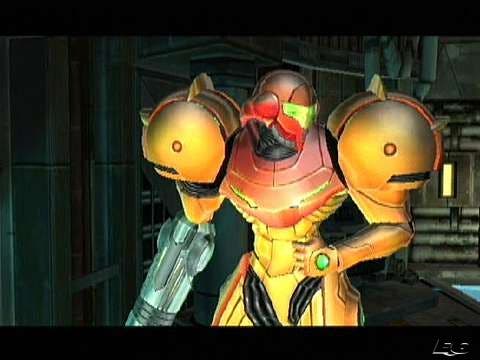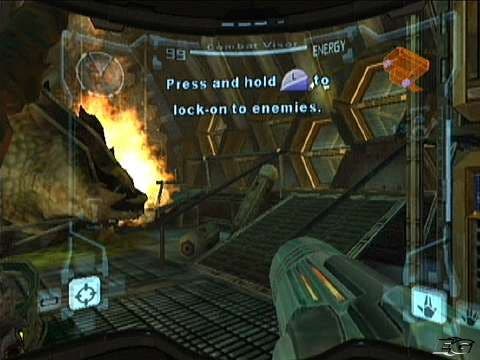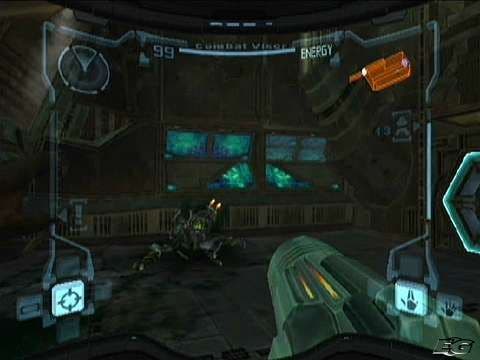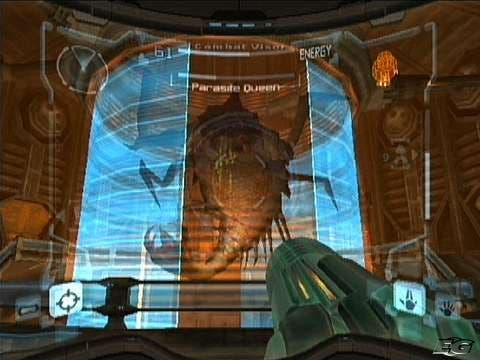Metroid Prime
Find out why Tom's been so busy lately...
When we first heard that Nintendo had handed development of Metroid Prime over to second party Retro Studios, we were mighty sceptical. Surely Intelligent Systems, the game's creator and masters of the 2D platform adventure, should be the ones proudly steering Samus Aran through her first 3D adventure? Many, many moons later and we've been playing Prime for a whole week, virtually unabated. Even the lure of brand new Christmas releases on many formats has had no effect. Our first impressions of Metroid Prime? It's Metroid in 3D, and it's so faithful to the series that we want to take back every last word we've said against Retro in the last few years. We want to withdraw our scepticism and revel with them in their success. And most of all, we want to finish this bloody article so we can get back to playing it.
And so to that we must get.

Prime Examples
First, think about your ideal 3D adventure. Instead of simply racing from one end of a level to the other, you find yourself scouring the game world for items which grant access to new abilities, allowing you to explore previously unassailable raised platforms, lava-soaked canyons, icy caverns, heck, even holes in the wall. Imagine 25 hours plus of lonely exploration as you traipse through enormous, varied environments, dispatching enemies who stream out of the ground like termites, flying mutant aggressors and screen (and trouser) filling boss creatures.
Imagine timed sections, the ability to morph into a ball (with perfect physics to match), gradations of armour to master, a scanner which reveals plot elements as you saunter through abandoned, malfunctioning Giger-esque labs with enough incidental detail to occupy Paris, seamless camera behaviour, a unique control system which grows on you like mildew and a first person view through the futuristic equivalent of a fireman's helmet, with an advanced HUD overlay.
It's Metroid folks, but not as we know it.

Have a ball
Metroid Prime begins in spectacular fashion. From the chimes of the menu music and the rolling background which looks like an electron microscope's eye view of some dangerous fungi, to the sight of a shiny-suited Samus arriving for business on an abandoned space station, the presentation is exquisite. And although Retro hasn't included a widescreen view (perhaps because the visor view would look, well, daft), amazingly for an NTSC game you can adjust screen position and even stretch the image! That's something we haven't seen in a, well, in a console game.
As Samus lands and gets out, the game opts for a Halo-esque calibration section. The player is asked to focus the scanner on several lights on the ground and in the air, and it's here that the unorthodox control system first makes itself known. Unlike many first person shooters, the left analogue stick controls movement (forward, back and turning). To look up and down you have to hold a button. So unless you're stationary, you can't look up and down! This seems quite awkward at first, but you soon learn that it's optimum - the reason being that Metroid is not a twibtch-kill exercise in reaction-testing. Enemy targeting is fully automatic. By the time you get to your first enemy, it's obvious that this is no Frontline in space.
And your first enemy is lying slumped on the ground, evidently having been plastered with some sort of buckshot. As you turn to face him, gripping the L trigger, the targeting reticule quickly and smoothly centres on him, leaving you to hammer the first button and watch the flesh fly. As more and more enemies appear in numbers, the lock-on feature typically targets the closest. In the absence of a discernible enemy, the targeting reticule sits in the centre and you can fire a few blasts whichever way you're facing - useful for opening doors which only respond to a certain kind of 'prodding'.

The Naked Bounty Hunter
The first level, set entirely on a space station, has you wondering through corridors decked with hanging tubes, venting exhaust pipes and mesh wiring. Labs are full of smashed cryo tubes and storage containers, computer consoles (either working or not), and railings/equipment galore. Many areas are interactive - hit left on the D pad to bring up the scanning visor view and by holding fire over a particular scannable object for a few seconds, Samus can download any information contained therein, which is subsequently stored in her logbook. I'm about six hours in now (admittedly with much replay) and my logbook already reads like War of the Worlds in print. It's useful to scan regularly, because often you'll round a corner and walk straight into a ceiling-mounted machine gun - if you'd scanned that last pad in the previous room that gun would be disabled.
As bounty hunters go, Samus is incredibly versatile. Right from the start she can fire a basic laser and a charge beam (which charms some doors which fail to respond to anything else), she can flip into scanning mode and often eke out information on how equipment/lifts/doors work or will open, and she can turn herself into a little morph ball. In this perfectly round shape, the analogue stick is used to move her around and it's probably fair to say that the movement physics here are the next best thing to those upon which Super Monkey Ball plies its entire trade. What's more, you can drop bombs in this mode - useful for detonating obstructions in tight spaces.
Of course it wouldn't be much of a Metroid game if you started off fully equipped, so having scoured the station, outed as much information as possible, passed locked containers which throb as their scaly, presumably rather dangerous occupants fling themselves against the metal plating, dispensed with many mutant nasties, polished off a boss queen who has a thing about bellowing wall-to-wall green death, and escaped before the station self-destruct obliterates everything, Samus is stripped of her abilities and dumped on Tallon IV.

Where in the which world?
Starting with a simple rocky, cave-packed environment, Samus has to gather all of her abilities by exploring the many, many routes the level offers, retracing her steps to open previously untouchable doors and reach unreachable platforms. It's a long and arduous process. Along the way, she'll have to dodge through cutting laser beams in classic 2D-in-3D platform gameplay (rather like Anakin's trip through the droid factory in Episode II), avoid being slaughtered by legions of rogue nasties, conquer many, many puzzles and collect enough information to make it all worthwhile.
Unlike the GBA Fusion game, Samus is quite alone in Prime, which is set just after the original NES adventure as she pursues a group of Space Pirates. It's a case of revealing the planet's secrets, scouring it in every direction for new tools, new openings and new toys, and traversing many different environments in order to put an end to the Metroid threat.

Not all perfect
So far, the pacing has been excellent, but I do have a few bugs to bear. First off, I'm not convinced that the switching between visor modes is fast enough. The animation is lovely - as it is with the transition to morph ball - but it feels a little cumbersome when you're in a hurry. And although I love the auto-targeting and the way that the game is structured to focus on exploration, puzzling and story, much as with the previous games in the series, I'm not wholly convinced that it's challenging enough. Once equipped with the map it's actually quite easy to work your way through different sections. It's no walk in the park but I've yet to come up against a puzzle I couldn't solve immediately - previous Metroids were famed for leaving you alone and confused armed only with the knowledge that you must have missed something.
I'm also not exactly thrilled by the respawning enemies - having to work your way back through various sections is one thing, but leaving only to return seconds later and find your targets once again full can be maddening.
The good news though is that for Metroid fans, Prime is going to answer prayers uttered ever since the shrink-wrap first came off Super Metroid: give us another worthy Samus Aran adventure. Based on our time with the game so far, Retro Studios have not only done that, but they've produced one of the most visually alluring sci-fi adventures to date, set to a reasonable pace and with so much to see, do and experience that we anticipate running through this one several times before we make our final evaluation.
Ultimately our biggest criticism is that we're forced to wait till March for this. If we had our way, Prime would be out now and it would swallow Nintendo fans' festive seasons in one tremendous guzzle. Sadly that's not to be, but if Metroid Prime doesn't turn out to be the Cube's best game so far, we'll don a metal suit and lay down some Aran justice ourselves.
And now, back to the fun.
Metroid Prime screenshots (Cube)
Metroid Prime preview (Cube)
Metroid Fusion review (GBA)
Metroid Fusion screenshots (GBA)

